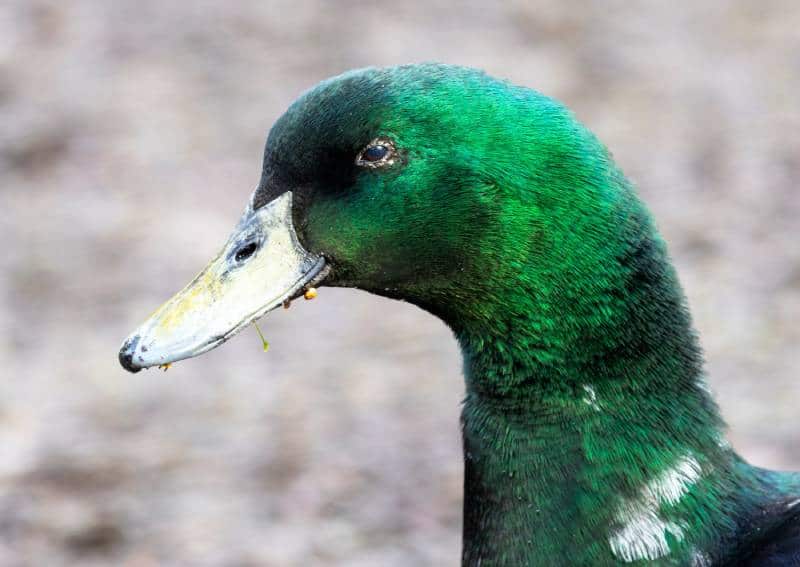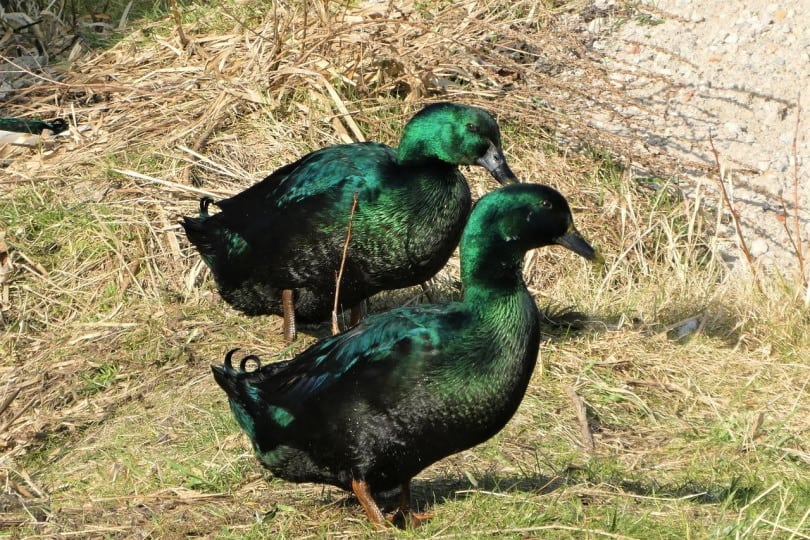If you are looking to add a small duck to an existing flock or start your own little community, the Black East Indian Duck has probably popped up on your radar. We can’t blame you. These ducks are insanely beautiful, touting exquisite iridescent feathering with adorable features.
On top of being beautiful, they are relatively easy to keep, even though they are not the best breed for any functional production. However, that does not mean that these ducks are useless on the farm. They actually serve a very noble purpose.
Let’s read more about these bantam beauties!

Quick Facts About Black East Indian Ducks

| Breed Name: | Black East Indian Duck |
| Place of Origin: | United States |
| Uses: | Ornamental |
| Drake (Male) Size: | 1.5 pounds |
| Hen (Female) Size: | 1 – 1.5 pounds |
| Color: | Iridescent black |
| Lifespan: | 10 years |
| Climate Tolerance: | Cold hardy, heat-friendly |
| Care Level: | Moderate |
| Production: | N/A |
| Temperament: | Reserved, quiet |
Black East Indian Duck Origin
The Black East Indian Duck is a bantam duck breed that, despite its misleading name, was developed in the United States. It is recorded as being the oldest of all bantam breeds, reaching the US for selective breeding sometime in the 20th century.
It was thought to have been created in the UK before arriving in the US, but its previous monikers give historians pause. These ducks have originally been called “Buenos Aireans” as well as “Labradors,” but there is no evidence linking them to those areas of the world, so the history of these ducks isn’t as clear-cut as some others.
Once the breed made a name for itself (being called the Black East Indian Duck), its popularity grew immensely and was prevalent in poultry shows. Even today, they are one of the very most popular breeds. They are a beautiful sight to behold with incredibly admirable features that woo keepers and professionals.
While these ornamental ducks don’t serve a practical purpose, they are extraordinary creatures that get lots of love for their unique appearance.

Black East Indian Duck Characteristics
The Black East Indian Duck is a bantam breed that stays very small in comparison to other breeds. These ducks are a pleasure to have on the farm, as they are very quiet and mind their own business.
These ducks are not the best candidates for pets in the traditional sense because they would prefer not to be around anyone but their own kind. They tend to be very pleasant, not bullying or snubbing any other poultry or farm life.
However, they’re not social birds to anything outside of their own species. They tend to stay in a tight-knit little group with other waterfowl.
Because of their reserved nature, they don’t make suitable birds for children who are wanting to raise ducks for the first time or use them as a 4-H project. The only way that that would work well is if the child fully understood that these ducks prefer solitude over company.
And if a lap duck is what you’re looking for, you might be sad about that as well. While these sweet little bantams are agreeable, they will likely start waddling away from you before you ever get near.
But on the upside, their reluctance to come close to you works in your favor when you’re trying to hurry everybody back in the coop at night. You just have to walk towards them, and they will herd like a flock of sheep back to where they belong.
Even though they might not be the friendliest ducks, they are very easy keepers due to their personalities. We must warn that these ducks can fly a bit but typically don’t, especially if they are adequately fed and in a stress-free environment.
They are definitely a look but don’t touch type, and we must respect that.

Uses
Since these little ducks are a bantam breed with low egg production and unsuitable meat weight, they are used mainly as ornamental or exhibition ducks.
However, they have a promising job, including being in charge of pesky garden insects. They will gladly clean out your flowerbeds and garden spaces of potentially detrimental insects. So they are pretty handy to have around despite their inadequacy in production.
The hens lay eggs that are quite small in size, but very unique. When they start laying at the beginning of the season, the eggs range from dark to almost black in color. As the season progresses, they lighten up significantly, gaining an iridescent hue comparable to their feathers.
Annually, one hen can lay up to 100 eggs. However, they can lay as low as 40. Because of the extreme variation, they are not dependable layers, and bantam eggs are much smaller in comparison.
Appearance & Varieties
These little bantam ducks are loved by fanciers everywhere due to their iridescent plumage. As their name implies, their base color is black, including their beaks and feet. Their feathers take on beautiful pearlescent shades of blues and greens.
Some females can develop white on their feathers. However, if a male develops any white coloring, it is considered a flaw in the breed which means you shouldn’t use those particular drakes for breeding. That is, of course, if you plan to breed them at all for show.
Do be careful. It is incredibly easy, even for experienced duck owners, to confuse the Black Indie with a Cayuga. However, the Cayuga is a full-sized duck that tends to have a little more green in its feathers than the Black East Indian Duck.
The difference might be more apparent when all of these ducks are fully grown. Bantams are significantly smaller than the full-sized Cayuga.

Population & Habitat
Surprisingly, the Black East Indian Duck is considered endangered today. However, that does not mean you can’t get your hands on a few. If you are able to, we recommend breeding if it is feasible for your setup. You could easily revamp the breed, as they are attractive and desirable for many fanciers.
Many people might mistakenly believe that because the Black East Indian Duck is a bantam breed, they require less water than traditional breeds. We have to stress that this is not true.
It is incredibly important for your duck to have a freshwater source. If you’ve owned ducks already, you know just how challenging it can be to keep the water clear.
If you have a small pond or a flowing water source, such as a creek or brook, these ducks will do very well. However, if you don’t have access to a natural water source, you will need to develop a system of providing them with suitable water to swim and forage.
The best route to take is to provide them with as much water as possible in your situation. That can vary from homestead to homestead, so do what is suitable for your setup.
These ducks can fly a little bit unless their wings are clipped. So, if you have them in an enclosure, it is essential to prevent flight to keep their wings protected. However, if you can free-range these ducks, they will be happiest.

Are Black East Indian Ducks Good for Small-Scale Farming?
Ultimately, this wonderful bantam breed can make an absolutely excellent addition to any small-scale farm. Due to their favorable size, they might be easier to keep, especially in coop living situations.
Even though these ducks were once prevalent, they have decreased in popularity and availability. So, make sure you do your homework to find out if there are any hatcheries or local community breeders near you.
Featured Image Credit: Elsemargriet, Pixabay
